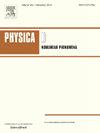Phase synchronisation in coupled oscillator chains with endpoint heterogeneity
IF 2.7
3区 数学
Q1 MATHEMATICS, APPLIED
引用次数: 0
Abstract
The emergence of collective dynamics within heterogeneous networks is a key feature of many biological networks. Heterogeneity of excitability, for example, has become a focus in the study of how pancreatic islets coordinate insulin secretion. This has raised the question of how highly excitable nodes might coordinate collective dynamics through networks where a large percentage of the population is intrinsically quiescent. To study this, we consider a discrete version of the Complex Ginzburg–Landau equation, parameterised such that in the absence of coupling, the endpoints exhibit globally attracting limit cycle behaviour and the interior nodes exhibit globally attracting trivial fixed point dynamics. Through model simulation and numerical continuation, we interrogate the relationship between model parameters and the stability of several phase-locked solutions of the system, focussing on two key solution types, the chevron and anti-phase chevron solutions, in which the exterior nodes exhibit a phase difference of 0 and , respectively. We find that the anti-phase chevron solution stabilises as the excitability of the interior nodes decreases, or as the shearing effect of non-zero, coupling-induced amplitude perturbations from the natural limit cycle increases. Moreover, we find multiple regions of bistability with solutions with different phase synchronisation properties, highlighting that solutions observed in such networks may depend sensitively on initial conditions. Overall, our work highlights that chains with distributed heterogeneity exhibit a multitude of phase synchronised solutions, which are likely to be relevant in a range of real world networks.
求助全文
约1分钟内获得全文
求助全文
来源期刊

Physica D: Nonlinear Phenomena
物理-物理:数学物理
CiteScore
7.30
自引率
7.50%
发文量
213
审稿时长
65 days
期刊介绍:
Physica D (Nonlinear Phenomena) publishes research and review articles reporting on experimental and theoretical works, techniques and ideas that advance the understanding of nonlinear phenomena. Topics encompass wave motion in physical, chemical and biological systems; physical or biological phenomena governed by nonlinear field equations, including hydrodynamics and turbulence; pattern formation and cooperative phenomena; instability, bifurcations, chaos, and space-time disorder; integrable/Hamiltonian systems; asymptotic analysis and, more generally, mathematical methods for nonlinear systems.
 求助内容:
求助内容: 应助结果提醒方式:
应助结果提醒方式:


